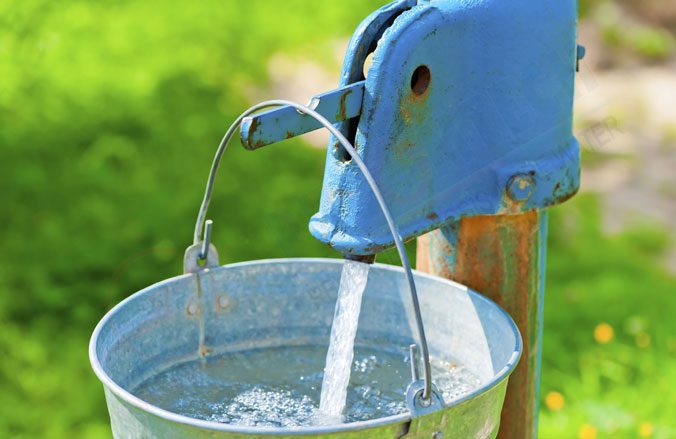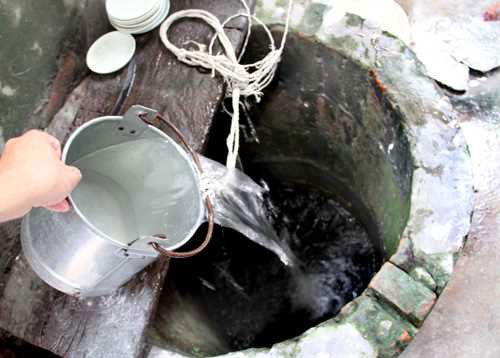Is well water safe to drink? What hidden dangers does it pose? When should you filter well water? All these questions will be answered in the following article!
Essential Information About Well Water
Currently, most households use purified water from home filtration systems or tap water for drinking and daily activities. However, in many rural areas and some residential communities, well water is still used.
In the past, well water was very clean and served as the primary source of water. However, due to increasing environmental pollution, soil contamination, and water pollution, the quality of well water has significantly deteriorated.
Composition and Characteristics of Well Water
Well water is essentially sourced from wells dug to a certain depth. Previously, people often sought out groundwater sources to dig wells for their domestic water needs.
Thus, well water is essentially groundwater (water that seeps deep into the ground, passing through various geological layers, dissolving many minerals, and removing impurities). Accordingly, well water is clean and rich in minerals.
Since it is drawn from deep underground, the characteristics and composition of well water can vary depending on geographical location, soil types, and depth.
Properties of Well Water

Well water is essentially groundwater.
Clean well water possesses physical properties: it is colorless, odorless, clear, and refreshing. However, nowadays, it is very challenging to find clean well water due to heavy groundwater pollution.
So, is well water still good?
The industrialization and modernization have severely degraded the atmospheric and water environments. The pollution is most evident in ponds, lakes, rivers, and even previously pure groundwater sources have experienced significant changes in their properties.
Therefore, well water (or groundwater) is no longer a safe choice for drinking and domestic use!
Is Well Water Good Today?
Discussing the cleanliness of well water? It can be affirmed that well water in the era of pollution contains many harmful impurities: chemicals, toxic organic compounds, heavy metals… which alter its chemical properties and pose potential health threats. Specifically:
Hard Water
When the concentration of calcium ions (Ca2+) and magnesium ions (Mg2+) exceeds safe limits, along with possible iron, aluminum, and manganese, it increases the hardness of the water, making it taste bitter.
This phenomenon may be due to limestone contamination in the well water, commonly occurring in limestone mountainous areas.
Hard water used for drinking can cause kidney stones and circulatory issues. Hard water used for bathing may lead to dry skin and hair, as well as damage to metal containers.
Low pH
Currently, well water has a lower pH than before. This raises concerns that the water may contain acids or acidic oxides.
Changes in the Characteristics of Well Water
Chemical and Heavy Metal Contamination
The process of urbanization and modernization, along with chemicals, industrial waste, and agricultural runoff, adversely affects household well water sources.
Well water often contains chemicals from fertilizers, pesticides, herbicides, and waste from livestock farming. If not treated properly, direct consumption can severely impact health.
Currently, well water may also harbor many heavy metals: Arsenic, lead, nitrate, iron, mercury, chromium… Arsenic can cause cancer, neurological disorders, and kidney damage.
Additionally, nitrate levels in well water are particularly harmful to infants. Lead can cause digestive disorders and brain damage.
The chemical changes in well water make it difficult to detect contamination. The most accurate way to identify polluted water and assess its quality is through well water testing.
However, you can also recognize changes in well water quality through physical indicators presented in the following section.
Signs of Contaminated Well Water
With ordinary senses, you can recognize signs of contamination in the well water you are using through the following specific indicators:
Cloudy Well Water
This is the most common phenomenon of well water today. Groundwater is infiltrated by impurities: algae, moss, parasitic bacteria, or organic material from decomposed animal and plant matter. As a result, well water is no longer as clear and clean as before.
Additionally, cloudy water may be due to shallow wells or wells that have not been dug deep enough to access cleaner, clearer groundwater.
Yellow Well Water (Well Water with Surface Film)
Another common condition is that well water, when drawn up from the well, develops a yellow film that floats on the surface after some time. This indicates that your household well water is contaminated with iron.
Iron exists in well water as Iron 2+ (Fe2+). When the water is drawn up, Fe2+ reacts with oxygen in the air, forming Iron II oxide precipitate, which causes the yellow color. This compound also gives the well water a foul odor that is unpleasant.
The above discussion explains why well water today no longer retains its original clean properties as before!
When you see well water exhibiting the obvious deterioration mentioned above, it is urgent to treat and filter the contaminated well water before using it for domestic consumption.
Depending on the quality of the water source and conditions, different treatment methods may be applied.

It is possible to visually identify whether well water is contaminated. (Illustrative image).
Methods for Treating and Filtering Household Well Water
Some methods for treating contaminated well water today include building filtration tanks, using chemicals, and utilizing household well water filtration devices.
Building a Filtration Tank
A filtration tank is a traditional method for filtering household water that has been used for a long time. The working principle of the filtration tank is based on biological self-filtration mechanisms.
The filtration system is constructed with three compartments: settling, filtering, and storage. The filtering layers use simple, readily available, and low-cost materials such as various sizes of sand, activated carbon, and gravel.
Building a filtration tank is often applied in rural areas where there is ample land. You can proactively construct a filtration tank with a capacity suitable for your well water filtration needs.
To this day, this method is still considered one of the inexpensive and fairly effective ways to filter well water.
Treating Well Water by Building a Filtration Tank
However, it is essential to recognize the limitations of the filtration tank method. The output water is only guaranteed to be free of large impurities and heavy metals but may still contain many bacteria and microorganisms in the water.
Additionally, building and maintaining a filtration tank can be quite labor-intensive and time-consuming. You need to regularly clean the tank to ensure water quality. Moreover, the filtered water stored in large tanks for extended periods can be prone to bacterial recontamination.
Chemical Treatment Methods
The chemicals used to treat contaminated well water are generally low in toxicity, easy to prepare, and do not cause side effects or affect water quality.
Commonly used substances include alum, activated carbon, kitchen ash, and lime in the process of filtering well water.
- Alum
Add an adequate amount of alum to the well water tank or container and stir well. After that, you will see the alum dissolve, forming a very thin layer on the water’s surface. This layer will gradually sink, pulling down dirt and impurities to the bottom.
Adjust the amount of alum added to the water to customize its clarity. Use the appropriate amount until the water becomes clear.
- Activated Carbon
Activated carbon is always a key component in water filtration. This material not only helps remove residues, dirt, and alum but also effectively absorbs odors.
However, this method should only be applied to water sources that are slightly contaminated with alum or lightly polluted.
- Wood Ash
You can neutralize alum in well water using just 5 to 10 grams of wood ash within a period of 15 to 20 minutes.
The substances in the alum-contaminated water will react with the components in the wood ash. Insoluble iron compounds will be removed, resulting in safe, clean water.
After the reaction occurs, the wood ash will settle at the bottom of the container. You can then carefully pour off the top layer of water that has been treated and use it.
- Lime
Similar to the method of using wood ash, you can add lime to the water and wait for the reaction to precipitate, settling at the bottom. Afterward, skim off the clean water on top for use.
However, both lime and wood ash are only temporary solutions for filtering well water contaminated with alum (iron) in very small amounts, and they do not provide optimal results if you want to filter larger quantities of well water.
- Other Chemicals
In addition to easily obtainable raw materials, you can use specialized chemicals. Chlorine-containing chemicals such as chloramine B in powder or tablet form, and calcium hypochlorite can effectively treat small volumes of well water stored in jars or containers.
However, the cleaned water is only recommended for washing and household activities, and should be avoided for drinking.
Using Well Water Filtration Devices
Traditional methods such as building filter tanks or using chemicals only partially address contaminated well water on a small scale and are not fully effective.
With the advancement of modern technology, we now have household well water filtration devices that offer superior filtration capabilities, requiring less effort and providing much more convenience.
These are large-capacity water purifiers—comprehensive water filters that can filter large volumes of well water, meeting optimal water filtration needs for households.
Such well water filtration devices are often referred to as stainless steel well water filter tanks. These devices utilize advanced RO technology with standard filtration stages.
The output water not only removes dirt, impurities, and heavy metals but also eliminates bacteria. This safe water can be used for all household drinking and living activities.
Investing in well water filtration devices is a smart investment that brings many benefits and incurs low costs in the long run. Improving water quality enhances living standards and protects family health, especially as well water sources have become less clean than before.




















































